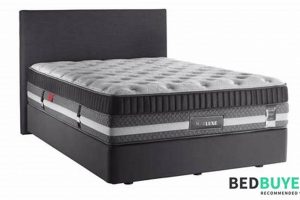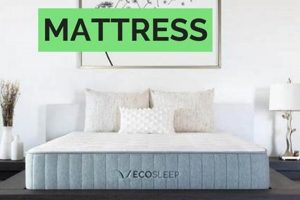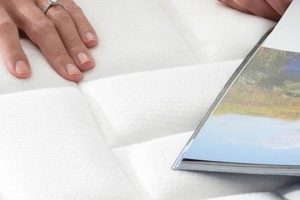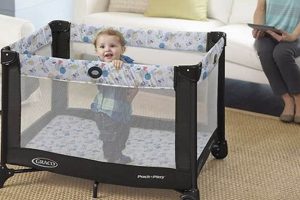A sleep surface utilizing a coil-based support system, often topped with various comfort layers, represents a traditional mattress design. The coil system provides the primary structure, offering support and bounce, while the upper layers, typically consisting of foams or fibers, enhance comfort and pressure relief. For example, models featuring individually wrapped coils tend to minimize motion transfer, an important consideration for couples.
The coil-based sleep system’s enduring popularity stems from its affordability, breathability, and inherent support characteristics. Historically, these mattresses were among the first mass-produced bedding options, establishing a foundational role in the sleep industry. Their springy nature allows for airflow, contributing to a cooler sleep environment, and the varying coil gauges and densities can cater to a range of body types and sleep preferences.
The subsequent discussion will delve into the factors influencing coil system quality, explore the types of comfort layers commonly employed, and offer guidance on selecting a coil-based sleep system aligned with individual needs and desired sleep experience. The focus will be on assessing durability, comfort, and overall value within this category of bedding.
Guidance for Optimal Selection
The following provides actionable advice for evaluating and choosing a coil-based sleep system. Careful consideration of these points can lead to a more informed purchase decision.
Tip 1: Assess Coil Gauge: Lower gauge numbers indicate thicker, firmer coils, providing greater support and potentially enhanced durability. Individuals requiring robust support should prioritize lower gauge options. For example, a 12-gauge coil offers more resistance than a 14-gauge coil.
Tip 2: Examine Coil Count and Configuration: Higher coil counts generally correlate with improved support and reduced motion transfer. Consider the coil configuration; pocketed coils minimize motion disturbance, while interconnected coils offer a more uniform feel. A mattress with 800 individually wrapped coils in a queen size is typically preferred over one with 400.
Tip 3: Evaluate Comfort Layer Materials: The materials used in the comfort layers significantly impact the overall feel. Memory foam offers conforming pressure relief, while latex provides a responsive and durable alternative. Fiberfill layers add cushioning and breathability. For example, a quilted top with natural fibers can enhance airflow and temperature regulation.
Tip 4: Consider Edge Support: Robust edge support prevents sagging and maximizes the usable sleep surface. Look for reinforced edges or coils specifically designed to provide perimeter stability. Sleeping near the edge of the sleep system requires firm edge support to avoid roll-off.
Tip 5: Research Warranty and Trial Periods: A comprehensive warranty and a sufficient trial period allow for thorough evaluation of the sleep system’s suitability. Understand the warranty terms and return policies before making a purchase. A trial period of at least 30 nights is recommended.
Tip 6: Check Independent Reviews: Independent product reviews from verified purchasers offer valuable insights into the mattress’s performance and longevity. Consult multiple sources to gain a balanced perspective. Focus on reviews that address long-term durability and comfort.
Tip 7: Factor in Sleeping Position: Side sleepers often benefit from a softer comfort layer to alleviate pressure on the shoulders and hips. Back sleepers typically require a firmer support core to maintain spinal alignment. Stomach sleepers need a relatively firm surface to prevent excessive sinking.
In summary, informed selection requires a careful evaluation of coil gauge, coil count, comfort layer materials, edge support, and warranty terms, combined with consideration of individual sleep preferences and body type. Consulting independent reviews provides additional valuable data.
The subsequent section will address common misconceptions associated with coil-based mattresses and provide further clarification on their construction and performance characteristics.
1. Coil gauge.
Coil gauge, a measurement of the thickness of the wire used in the support coils, is a critical determinant of firmness and support characteristics within a coil-based mattress. Its selection significantly impacts the suitability of a mattress for different body types and sleeping preferences.
- Gauge and Firmness
Lower gauge numbers signify thicker coils, resulting in a firmer sleep surface. Thicker coils offer greater resistance to compression, providing enhanced support for heavier individuals or those preferring a more rigid feel. For example, a 12-gauge coil will feel firmer than a 14-gauge coil. The choice impacts spinal alignment and pressure distribution.
- Gauge and Durability
Thicker coils, associated with lower gauge numbers, tend to exhibit greater resilience and resistance to wear over time. Mattresses constructed with lower gauge coils often demonstrate improved longevity, maintaining their support characteristics for an extended period. This directly influences the overall value proposition of the sleep system.
- Gauge and Suitability for Sleep Positions
Individuals who primarily sleep on their stomachs or backs often benefit from a mattress with lower gauge coils. The enhanced support helps maintain proper spinal alignment in these positions. Side sleepers, however, may find lower gauge coils too firm, leading to pressure points on the shoulders and hips.
- Gauge and Combination with Comfort Layers
The chosen gauge should complement the properties of the comfort layers. A mattress with thicker coils may be paired with thicker, more plush comfort layers to provide a balance of support and pressure relief. Conversely, thinner coils might be combined with thinner comfort layers to maintain a firmer overall feel. The interaction between these layers dictates the ultimate sleep experience.
The selection of an appropriate coil gauge represents a fundamental decision in the pursuit of an optimally supportive and comfortable coil-based sleep system. A gauge that aligns with individual needs and preferences is paramount to achieving restorative sleep. Furthermore, the coil gauge determines whether an sleep system provides proper spinal alignment and long-term durability, the choice of coil gauge will determine if the final product is considered one of the mattresses.
2. Coil count.
Coil count, representing the number of individual coils within a mattress core, is a significant factor influencing support, conformity, and motion isolation, characteristics often associated with a high-quality coil-based mattress. A higher coil count, gene
rally speaking, indicates a more densely packed support system. This increased density distributes weight more evenly across the mattress surface. The resultant effect is reduced pressure points and improved spinal alignment. For instance, a queen-size mattress featuring 800 independently wrapped coils is likely to offer more targeted support than one with only 400.
Furthermore, coil count impacts motion isolation. Individually wrapped or “pocketed” coils are particularly effective in minimizing motion transfer. When one sleeper moves, the surrounding coils absorb the disturbance, preventing it from propagating across the mattress surface. This feature is especially beneficial for couples or individuals sharing a bed. Consider the practical scenario of one partner frequently tossing and turning; a high coil count system with pocketed coils can significantly reduce the disruption experienced by the other partner. However, coil count alone is not the sole determinant of quality; coil gauge, material composition, and the design of comfort layers also play crucial roles. Systems using interconnected coils may not provide the same motion isolation benefits, regardless of the number of coils present.
In summary, coil count is an important indicator of potential support and motion isolation capabilities in a coil-based sleep system. However, it must be considered in conjunction with other factors, such as coil gauge and comfort layer composition, to fully assess the overall suitability of the mattress. Focusing solely on coil count without considering these other variables may lead to a less-than-optimal sleep experience. The selection of an sleep system requires a balanced evaluation of all contributing elements.
3. Comfort Layers.
Comfort layers represent an essential component of a coil-based sleep system, directly influencing the perceived feel and overall sleep experience. While the coil system provides foundational support, the comfort layers determine the initial point of contact and contribute significantly to pressure relief and temperature regulation.
- Material Composition and Feel
Various materials comprise comfort layers, each possessing unique characteristics. Memory foam conforms closely to the body, offering significant pressure relief, while latex provides a more responsive and buoyant feel. Polyfoam serves as a cost-effective option, and natural fibers such as cotton or wool contribute to breathability and moisture-wicking properties. The specific combination of these materials dictates the overall feel of the sleep system, ranging from plush to firm. For example, a mattress featuring a thick layer of memory foam over a coil core provides a distinctly different feel than one with a thin layer of polyfoam.
- Thickness and Pressure Relief
The thickness of the comfort layers correlates directly with the degree of pressure relief provided. Thicker layers generally offer greater cushioning and contouring, alleviating pressure points on areas such as the shoulders, hips, and knees. Individuals experiencing joint pain or preferring a more cradled feel may benefit from a mattress with thicker comfort layers. However, excessive thickness can lead to a feeling of being “stuck” in the mattress, hindering movement.
- Density and Durability
The density of the materials used in the comfort layers significantly impacts their long-term durability. Higher-density foams and fibers tend to resist compression and maintain their shape over time, extending the lifespan of the mattress. Lower-density materials are more prone to sagging and degradation, potentially compromising support and comfort. Investing in a sleep system with high-density comfort layers is essential for ensuring long-term value.
- Influence on Temperature Regulation
Comfort layers can significantly impact temperature regulation during sleep. Certain materials, such as open-cell memory foam or latex, promote airflow and dissipate heat more effectively than traditional memory foam. Natural fibers also contribute to breathability and moisture wicking, helping to maintain a comfortable sleep environment. Choosing materials with inherent cooling properties can mitigate the risk of overheating and improve sleep quality.
The careful selection of comfort layer materials, thickness, and density is crucial for achieving an optimal balance of comfort, support, and durability in a coil-based mattress. The integration of these layers with the underlying coil system determines the overall suitability of the sleep system for individual needs and preferences. A truly exceptional innerspring mattress will feature comfort layers that complement the support core, creating a harmonious and restorative sleep surface.
4. Edge Support.
Edge support refers to the structural reinforcement along the perimeter of a mattress, a critical attribute contributing to the overall functionality and perceived quality of a coil-based sleep system. Inadequate edge support leads to compression and sagging along the mattress edges. Consequently, the usable sleep surface diminishes, creating a sensation of instability and potential “roll-off,” particularly disruptive for couples or individuals who utilize the full width of the mattress. Robust edge support, conversely, maximizes the sleepable area, providing consistent support from edge to edge and facilitating comfortable sitting along the perimeter. As a component, it contributes to the overall longevity and user satisfaction, factors directly linked to considering it as a contender in the list of best innerspring mattress
Different methodologies achieve edge support. Encasing the perimeter coils in high-density foam, a common practice, provides a stable and supportive edge. Some designs incorporate a network of thicker gauge coils along the border to resist compression. Hybrid systems may combine both foam encasement and reinforced coils for enhanced stability. A person sitting on the edge of a well-designed mattress should experience minimal compression and maintain a comfortable, upright posture. In contrast, a mattress with poor edge support will exhibit significant sagging, forcing the user to exert effort to maintain balance.
The presence of adequate edge support fundamentally impacts the usability and lifespan of a coil-based mattress. It improves sleep quality by maximizing the available sleep surface and enhancing the overall structural integrity of the system. Selecting a mattress with robust edge support represents a practical investment, contributing to both immediate comfort and long-term durability, characteristics defining a quality coil based option.
5. Motion Isolation.
Motion isolation, the capacity of a mattress to minimize the transfer of movement from one area to another, is a significant factor when evaluating the suitability of a coil-based sleep system, especially when considering it for selection as a high-quality choice. In scenarios involving two sleepers, one partner’s movements can disrupt the other’s rest if the mattress lacks adequate motion isolation. This disruption manifests as a noticeable ripple effect felt across the sleep surface. The fundamental cause of motion t
ransfer in coil-based systems lies in the interconnectedness of the coils; movement in one area triggers a corresponding response in adjacent coils. However, advanced designs mitigate this effect through specific engineering techniques. For instance, individually pocketed coils, where each coil is encased in fabric, function independently, thereby reducing the propagation of movement. Similarly, carefully selected comfort layers, such as high-density memory foam, can absorb and dampen motion, further enhancing motion isolation. The effectiveness of motion isolation directly impacts sleep quality; reduced disturbance translates to fewer sleep interruptions and improved overall rest.
Considering real-life examples, a light sleeper sharing a bed with a partner who frequently tosses and turns would greatly benefit from a mattress with exceptional motion isolation. Such a system would allow the light sleeper to remain undisturbed despite the partner’s movements. Conversely, a mattress with poor motion isolation would amplify the disturbances, leading to fragmented sleep and reduced daytime alertness. This attribute also holds value for individuals sharing a bed with pets or those prone to nighttime movements. The practical application of motion isolation extends beyond couples; any individual seeking uninterrupted sleep can benefit from a system designed to minimize motion transfer. Selecting a coil-based sleep system prioritizing this functionality contributes directly to improved sleep hygiene.
In summary, motion isolation constitutes a critical attribute for the selection of a coil-based mattress, particularly when shared occupancy is a factor. The design elements contributing to motion isolation, such as individually pocketed coils and high-density comfort layers, directly influence the system’s ability to minimize sleep disruption. While coil-based systems traditionally faced challenges in this area, advancements in design and material science have produced options offering comparable, and in some instances superior, motion isolation compared to other mattress types. Evaluating motion isolation necessitates a comprehensive assessment of the mattress’s construction, with particular attention paid to the coil system and comfort layer composition. Prioritizing motion isolation translates to an enhanced and more restorative sleep experience. The selection and engineering of “Motion Isolation” attributes are what separate regular mattresses from “Best innerspring mattress”.
6. Durability.
Durability represents a cornerstone characteristic in the evaluation of coil-based sleep systems. The inherent longevity of a mattress directly impacts its overall value proposition. A coil-based system deemed to be among the best must exhibit resistance to degradation over time, maintaining its support and comfort characteristics throughout its intended lifespan. Premature sagging, coil failure, or disintegration of comfort layers render the system ineffective, negating any initial cost savings. Consider the case of a mattress purchased for its initial comfort, only to develop significant indentations within a year; the compromised support leads to discomfort and potential musculoskeletal issues. Therefore, durability functions as a primary determinant of long-term satisfaction.
Several factors contribute to the durability of a coil-based sleep system. The gauge and quality of the coils themselves play a critical role; thicker gauge coils constructed from high-quality steel demonstrate greater resistance to deformation under sustained weight. The density and composition of the comfort layers are equally significant. High-density foams and resilient natural fibers retain their shape and cushioning properties for a longer duration compared to lower-density alternatives. Furthermore, the construction methods employed, such as reinforced edge support and secure quilting, contribute to the overall structural integrity and longevity of the system. Regular rotation of the mattress, as recommended by the manufacturer, also helps to distribute wear evenly, extending its lifespan. The selection of a durable mattress translates to a long-term investment in sleep health and well-being.
In summary, durability is an indispensable component of a high-quality coil-based sleep system. The use of robust materials, meticulous construction techniques, and adherence to recommended maintenance practices directly influence the system’s lifespan and sustained performance. While initial cost may be a consideration, prioritizing durability ensures long-term value and mitigates the risk of premature replacement. A durable mattress delivers consistent support and comfort, contributing to restorative sleep and improved overall health. Therefore, evaluating a potential option, one must verify coil composition, construction, and manufacturing process. Verifying this would provide a higher confidence in considering and investing in “Best innerspring mattress”.
Frequently Asked Questions About Coil-Based Sleep Systems
This section addresses common inquiries and clarifies key aspects of coil-based mattress technology to facilitate informed purchasing decisions.
Question 1: What coil gauge represents the best option for optimal support?
The ideal coil gauge is contingent upon individual body weight and preferred sleep position. Lower gauge numbers, signifying thicker coils, provide enhanced support for heavier individuals or those favoring firmer surfaces. Conversely, higher gauge numbers offer a softer feel, potentially more suitable for lighter individuals or side sleepers.
Question 2: Does a higher coil count invariably indicate superior mattress quality?
While a higher coil count generally correlates with improved support and reduced motion transfer, it is not the sole determinant of quality. Coil gauge, material composition, and construction methods also significantly influence overall performance. A balanced assessment of these factors is essential.
Question 3: What distinguishes pocketed coils from interconnected coil systems?
Pocketed coils, individually encased in fabric, operate independently, minimizing motion transfer. Interconnected coil systems, where coils are linked together, provide a more uniform feel but offer less targeted support and motion isolation.
Question 4: How does the composition of comfort layers influence the sleep experience?
Comfort layer materials significantly impact pressure relief, temperature regulation, and overall feel. Memory foam conforms closely to the body, while latex provides a more responsive surface. Natural fibers enhance breathability. The selection of appropriate materials is crucial for achieving desired comfort characteristics.
Question 5: What constitutes adequate edge support in a coil-based mattress?
Adequate edge support prevents sagging and maximizes the usable sleep surface. Look for reinforced edges, high-density foam encasement, or perimeter coils specifically designed to provide stability. Consistent support from edge to edge enhances comfort and prevents roll-off.
Question 6: How can the longevity of a coil-based sleep system be maximized?
Maximizing lifespan involves selecting a mattress with robust materials and construction, adhering to recommended rotation schedules, and utilizing a supportive foundation. Regular cleaning and protection from excessive moisture also contribute to long-term durability.
In summary, a thorough understanding of coil gauge, coil count, comfort layer composition, edge support, and maintenance practices
enables informed decision-making when selecting a coil-based sleep system.
The following section will explore alternatives to coil-based systems and provide a comparative analysis of their respective strengths and weaknesses.
Conclusion
The preceding analysis elucidates the critical factors underpinning the selection of a quality coil-based sleep system. Coil gauge, coil count, comfort layer composition, edge support, motion isolation, and durability collectively determine the long-term performance and suitability of such a product. Identifying the best innerspring mattress necessitates a thorough evaluation of these attributes, aligned with individual sleep preferences and physical requirements.
The information presented serves as a foundation for informed consumer decision-making within the bedding market. Prospective purchasers are encouraged to apply this knowledge to evaluate available options, prioritizing objective assessment over subjective marketing claims. The ultimate goal remains achieving restorative sleep and maximizing long-term value through the selection of an appropriately designed and constructed mattress.


![Top-Rated: Choosing the Best Mattress Foundation [Guide] Organic & Natural Mattress Buyer’s Guide: Non-Toxic Sleep Solutions Top-Rated: Choosing the Best Mattress Foundation [Guide] | Organic & Natural Mattress Buyer’s Guide: Non-Toxic Sleep Solutions](https://mattressworldpa.com/wp-content/uploads/2025/07/th-7633-300x200.jpg)




![How to Find the Best Way Twin Air Mattress [Guide] Organic & Natural Mattress Buyer’s Guide: Non-Toxic Sleep Solutions How to Find the Best Way Twin Air Mattress [Guide] | Organic & Natural Mattress Buyer’s Guide: Non-Toxic Sleep Solutions](https://mattressworldpa.com/wp-content/uploads/2025/07/th-7628-300x200.jpg)